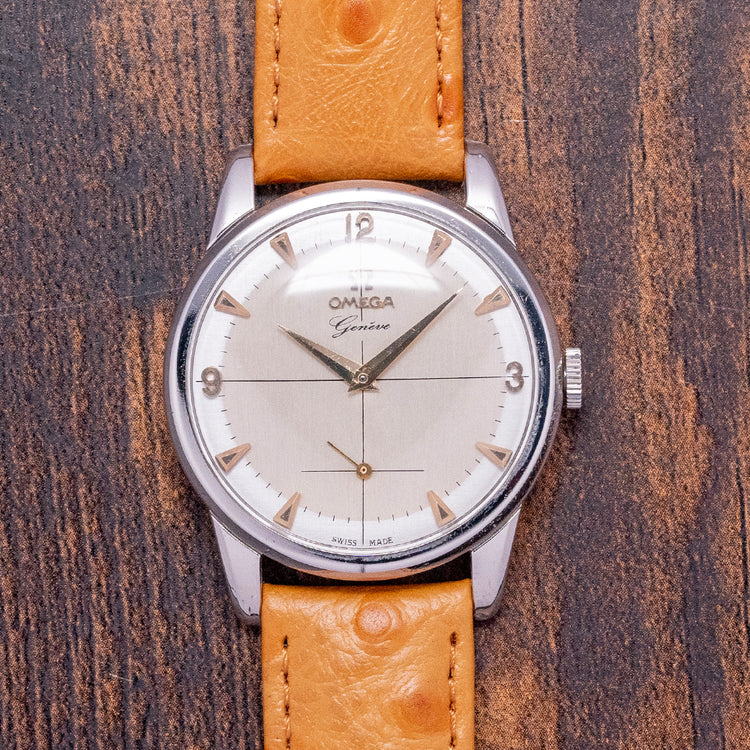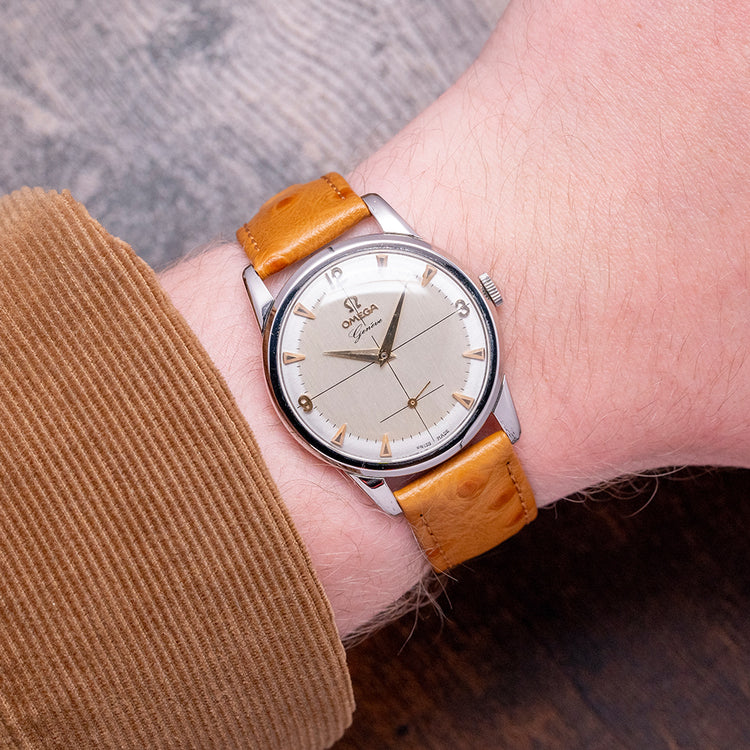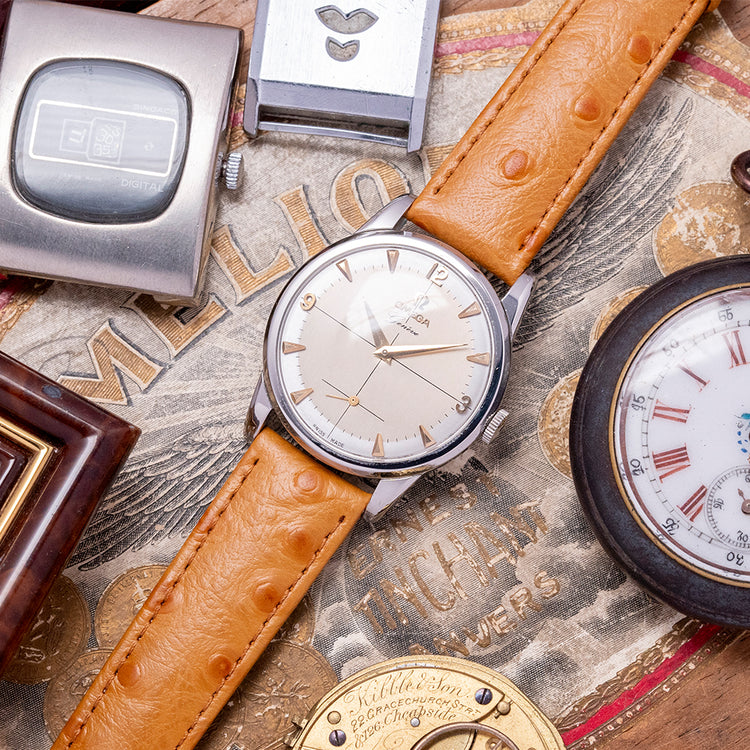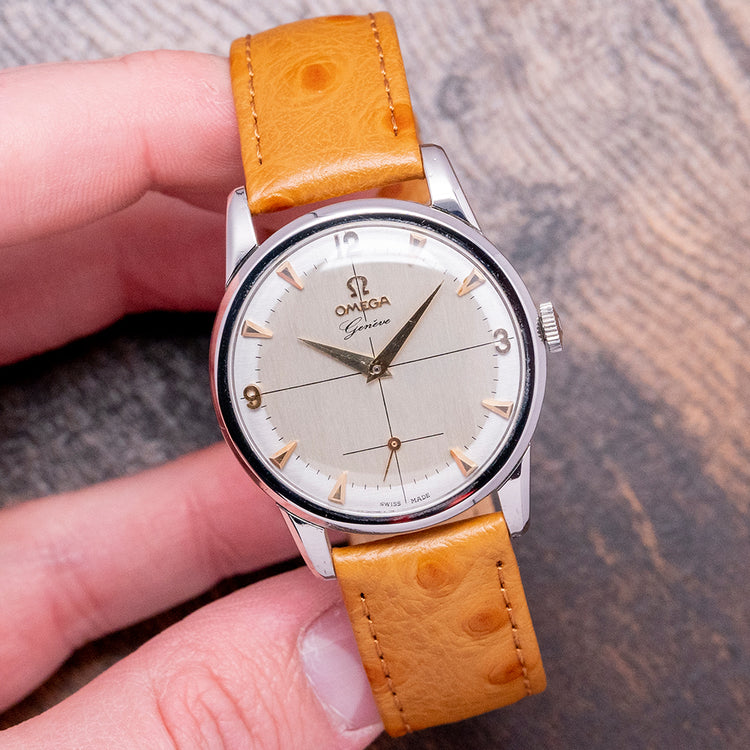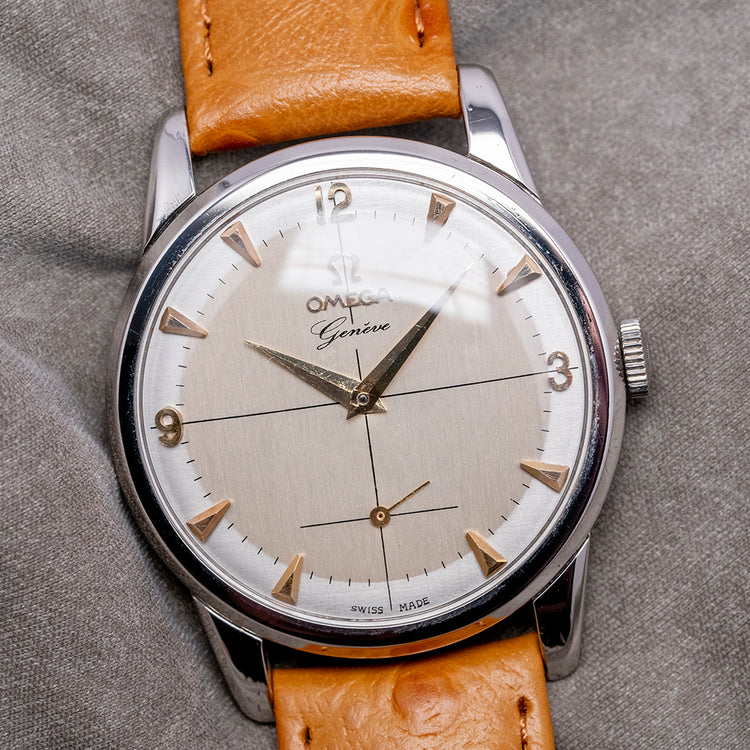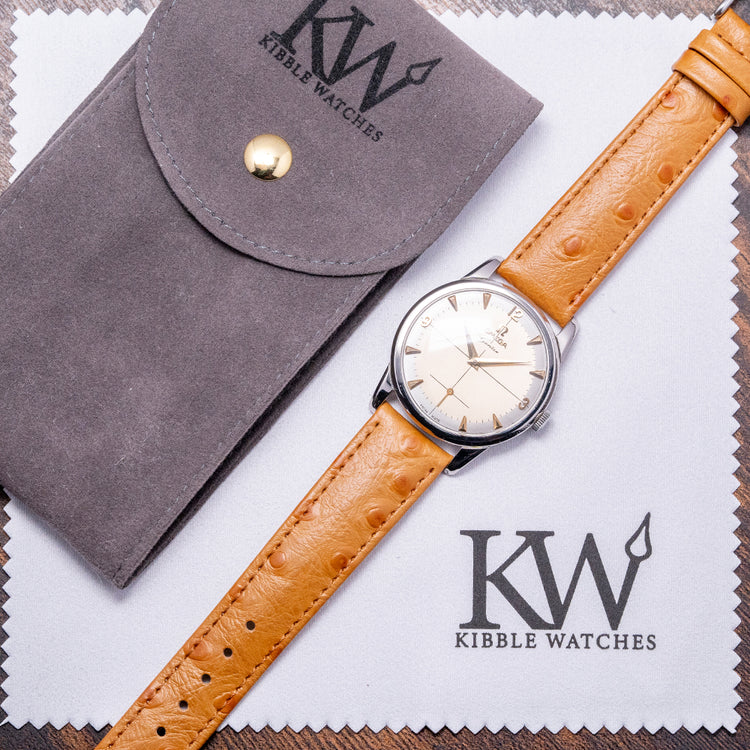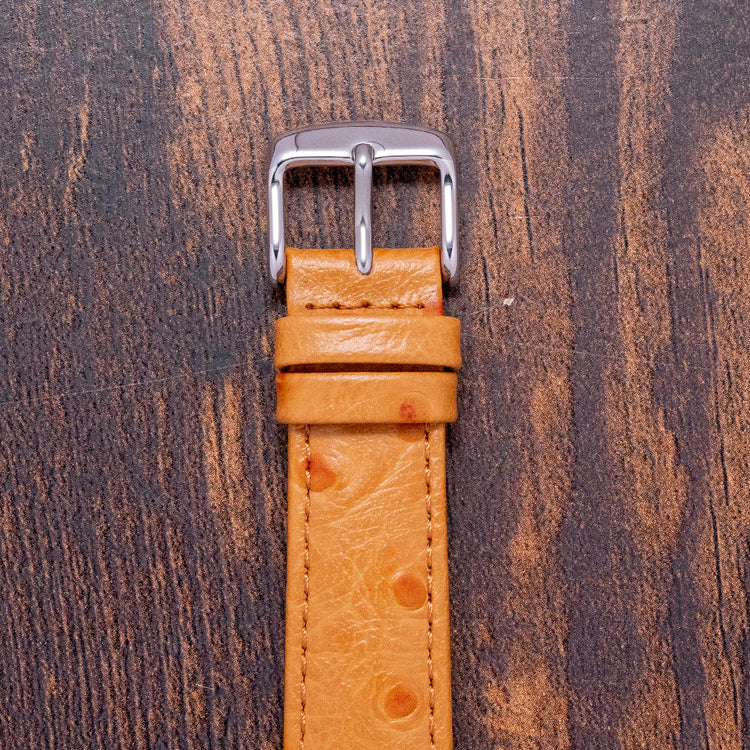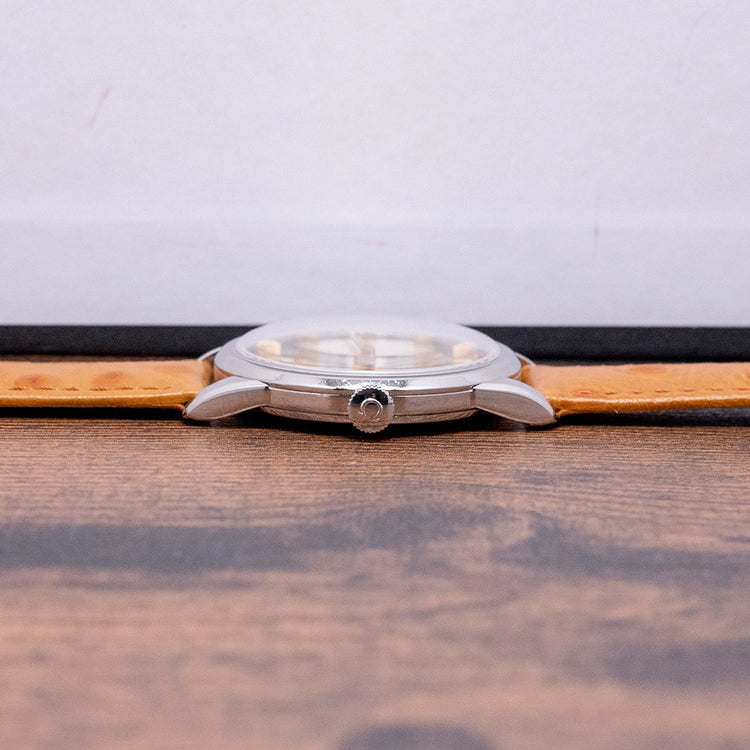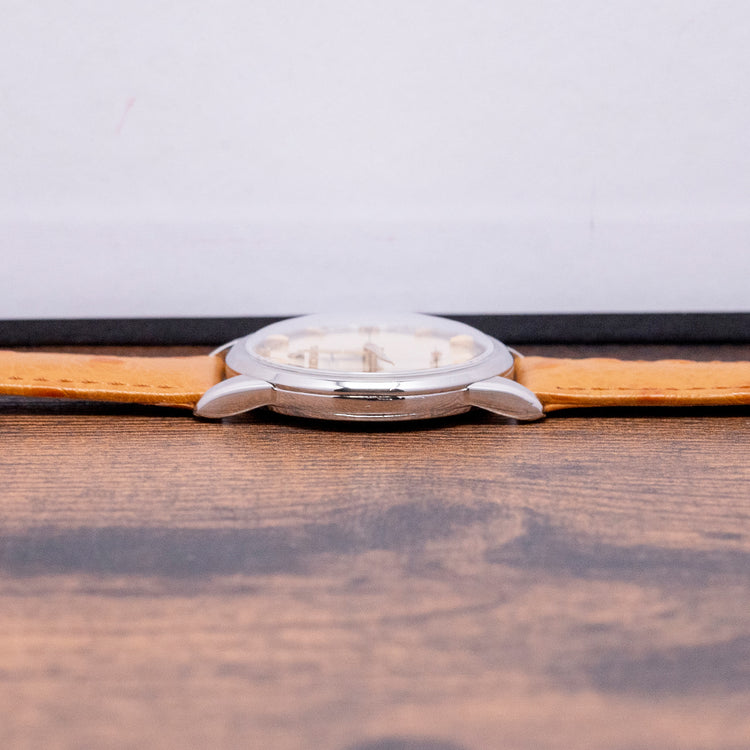More Information
Description
More
Less
More
Less
Here we have a 1954 Omega Geneve Manual Cal. 266 2754-2 with a 34mm round stainless steel case that curves over your wrist with tapered lugs. Its curvaceous flanks lead to a lug-to-lug length of 41mm and a case thickness of just 8.5mm, ensuring a comfortable fit. On the right side, there is a coin-edged crown. The smooth bezel holds a domed crystal above a striking two-tone silver cross-hair dial. Gold applied Arabic numerals and facet dagger indexes mark the hours, gold coloured Dauphine hands sit above a cross-hair running seconds at 6 o’clock; at 12 o’clock, we have the Omega Geneve motif completing this versatile vintage timepiece. On the reverse, a snap-off case back, inside a manually wound Omega Cal. 266, 17 jewels, beating at a leisurely 18,000 beats per hour. This movement has a Breguet hairspring and Incabloc shock protection; it was manufactured from 1939 until 1963. It comes paired with an 18mm well-suited leather strap.
Points of Mention
More
Less
More
Less
This watch is sold as "Watch Only" and therefore comes with no original box or paperwork. It comes paired with an 18mm well-suited leather strap. The watch is from Circa. 1954 and is sold in worn, vintage condition, and a very nice quality, beautifully refinished dial, as you can see. The watch comes with our 12-Months NON-Waterproof Warranty.
Personal Note
More
Less
More
Less
Some people see the world 'refinished' and immediately turn away, though this wonderful example is the perfect testament to how a good refinished dial can look. This was refinished some time ago, but completely to a great standard and elevating the look. Unfortunately, we will never know why it was refinished, but the common cause is water damage, and I would much rather see a watch look this beautiful again than be put into a parts bin. This reference 2754-2 comes in a great 34mm case that wears beautifully on the wrist and is powered by the great manually wound Omega Calibre 266. I would not hesitate to add this fantastic example to your collection today!
Specification
More
Less
More
Less
Reference : 2754-2
Movement : Manually Wound Omega Cal. 266
Age : Circa. 1954
Year : 1954
Case Size : 34mm
Case Thickness : 8.5mm
Lug to Lug : 41mm
Lugs : 18mm
Condition : Pre-Owned
Box and Papers : None
Case Material : Stainless Steel
Warranty : 12 Months NON-Waterproof Warranty
The wrist model's wrist size is 7inch
Movement : Manually Wound Omega Cal. 266
Age : Circa. 1954
Year : 1954
Case Size : 34mm
Case Thickness : 8.5mm
Lug to Lug : 41mm
Lugs : 18mm
Condition : Pre-Owned
Box and Papers : None
Case Material : Stainless Steel
Warranty : 12 Months NON-Waterproof Warranty
The wrist model's wrist size is 7inch
About Omega
More
Less
More
Less
They were formerly known as the La Generale Watch Co., founded in 1848 by Louis Brandt in La Chaux-de-Fonds. When he died in 1879, his sons carried on his dream. In 1880, they moved to 96 Rue Jakob-Stampfli, where they remain today. The brothers produced their first mass-produced calibre, the Labrador, in 1885. Just a few years later, in 1892, they produced the first minute-repeater. In 1903, they renamed the company Omega until 1982, when they officially changed their name to Omega SA. During WW1, Omega watches were used as official timekeepers for the Royal Flying Corps and the US Army. In 1930, Omega and Tissot merged together to form Société Suisse pour l'Industrie Horlogère (SSIH). In 1931, another group was formed - Allgemeine Schweizerische Uhrenindustrie AG (ASUAG). Where SSIH was primarily French-speaking, ASUAG was founded by the more German-speaking members of the Swiss watch industry. In 1948, they introduced the first edition of one of their most symbolic watches: the Seamaster. Omega first introduced the Constellation in 1952. At the time, it was Omega's flagship timepiece. The first models had a Cal. 354 bumper movement in them. Later in 1955, Omega introduced the Automatic Cal. 50x, followed in 1959 by the Cal. 55x (no date) and 56x (date) versions. Many of the Constellations came with pie-pan dials, diamond indexes, and fancy lug configurations. All the gold Constellations of that time have the Observatory of Geneva's hand engraved on the back. The stainless steel and stainless steel/gold versions had a gold medallion on the back with the Observatory of Geneva. The eight stars above the Observatory stand for the many exploits of Omega in the world Chronometer competition. Celebrating the fact that all Constellations are Chronometer Certified. In 1962, when astronaut Wally Schirra wore a Speedmaster on his Mercury Sigma 7 Mission, making it the first Omega watch to enter space. After rigorous tests, NASA used Omega for all their Apollo missions, including the 1969 Moon landing of Apollo 11. Today Omega is still an astronaut's first choice. In 1969, President Nixon famously said it was “too valuable” and turned down the first-ever all-gold Speedmaster Professional Deluxe. As a response to the ever-growing threat of electronic watches to the manufacturers of mechanical watches, Omega and many Swiss brands such as Rolex and Patek Philippe formed Centre Electronique Horologer (CEH). Prototypes began to appear in 1967 with their production starting in 1968. Then in 1972, Omega introduced the reference, 198.030, which included the Omega calibre 1250, a ‘tuning-fork electronic movement which was made under licence from Bulova. Later we saw a merger of SSIH and ASUAG into SMH, or Société de Microélectronique et d’Horlogerie. This merger took place in 1983. In 1992, the company acquired Blancpain, and in 1998, it officially rebranded itself from SMH to the Swatch Group. Then, in 1999, they purchased and integrated Breguet into the Swatch Group.
Description
Here we have a 1954 Omega Geneve Manual Cal. 266 2754-2 with a 34mm round stainless steel case that curves over your wrist with tapered lugs. Its curvaceous flanks lead to a lug-to-lug length of 41mm and a case thickness of just 8.5mm, ensuring a comfortable fit. On the right side, there is a coin-edged crown. The smooth bezel holds a domed crystal above a striking two-tone silver cross-hair dial. Gold applied Arabic numerals and facet dagger indexes mark the hours, gold coloured Dauphine hands sit above a cross-hair running seconds at 6 o’clock; at 12 o’clock, we have the Omega Geneve motif completing this versatile vintage timepiece. On the reverse, a snap-off case back, inside a manually wound Omega Cal. 266, 17 jewels, beating at a leisurely 18,000 beats per hour. This movement has a Breguet hairspring and Incabloc shock protection; it was manufactured from 1939 until 1963. It comes paired with an 18mm well-suited leather strap.
Points of Mention
Personal Note
Specification
The Brand
Enquire or Book an Appointment
Would you like to discover further details about this watch, or perhaps arrange an appointment to view and try it on? Complete this form and a member of our team will get back to you shortly.
You May Also Like


























